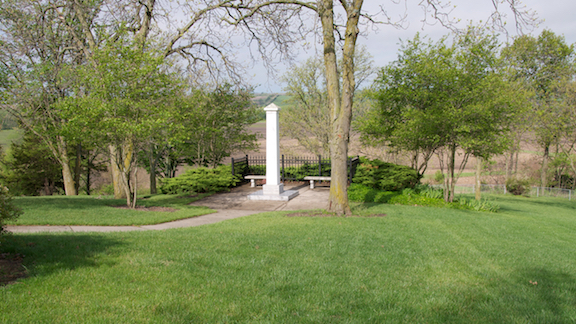Mount Pisgah
Mount Pisgah was a temporary settlement along the Mormon Trail. It was one of three temporary way stations that Latter-day Saints established in central Iowa during the Saints’ exodus from Nauvoo. As many as 3,000 pioneers lived in Mount Pisgah and thousands more stopped there briefly on their trek to the West.
- After the pioneers established one stopping place at a spot they named Garden Grove, Apostle Parley P. Pratt and an advance company were sent ahead to scout out another potential location. They found a seemingly ideal prospect, with tall grass blanketing rolling hills “crowned with beautiful groves of timber.” In the plain below, the main branch of the Grand River meandered through trees and prairie grass. Struck by the site’s beauty, Elder Pratt christened the place Mount Pisgah, after the biblical height from which Moses surveyed the promised land. Here the Saints built homes and two log meetinghouses on a hillside overlooking a thousand acres of buckwheat, corn, turnips, potatoes, peas, beans, pumpkins, and squash they had planted in the plain below.[1]
Mount Pisgah provided a place for the beleaguered Saints to rest and prepare for their long journey. The Saints were not spared further hardship as illness was pervasive there.
The settlement was abandoned in 1852 when Church leaders directed any Saints remaining to gather to Utah Territory.
A monument—a 12-foot-high obelisk—was erected to honor those Latter-day Saint pioneers who died there. At least 80 people died within their first year of residence. The cemetery likely includes the graves of about 150 Saints, but the monument provides the name of 63 of those who were interred there; the markers are long gone.
The History of the Monument
- English immigrant and handcart pioneer Hannah Settle Lapish was visiting family in Montana in late summer 1885. While browsing a bookshelf at the home of her daughter’s neighbor, she leafed through a book on the geography of Union County, Iowa, and stumbled across a reference to Mount Pisgah, Iowa, a name she recognized from Church history. She was astonished to learn that the neighbor’s widowed mother and brother, who lived in Iowa, owned the land on which the Mount Pisgah cemetery was located. Although Sister Lapish, who had come to America in 1860, had never visited Mount Pisgah, she felt that others might have an interest. She suggested that the family notify Church leaders that they owned the cemetery.[2]
- Albert C. White, one of the owners of the land, soon wrote to President John Taylor. He noted that while he had long cultivated the fields surrounding the old burying ground, he had made sure that the graves were undisturbed. He wondered if the Latter-day Saints might wish to “in some way mark the place.” President Taylor asked Oliver B. Huntington, son of William Huntington, to contact relatives of the deceased to see how they felt about the idea. The desire to remember and honor their loved ones was strong. Acting on President Taylor’s instructions, Huntington responded to White with an offer to purchase one acre of ground. The purchase was finalized on May 3, 1886.[3]
- With the land in Church ownership, Huntington and White entered into a remarkable partnership. From Utah, Huntington wrote dozens of letters and placed notices in newspapers to solicit donations from friends and relatives of the dead. In Iowa, White coordinated landscaping, identified fencing options, and designed a monument. Huntington then drafted the text to be engraved on the marble shaft, and White oversaw its installation. Although the two men never met, they became good friends.[4]
- Donations trickled in from children and grandchildren, brothers and sisters, parents and friends. Among those making donations were Elders Lorenzo Snow and Franklin D. Richards, whose infants’ names were to be inscribed on the monument. The Quorum of the Twelve Apostles, most of whom had passed through Mount Pisgah on their way west, authorized a major donation from Church funds. By the fall of 1888, 42 years after the first burial at Mount Pisgah, a monument was in place.[5]
